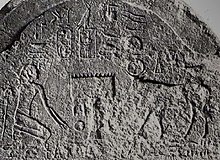
Back Kambuses Afrikaans قمبيز الثاني Arabic قمبيز التانى ARZ II Kambiz Azerbaijani ایکینجی کمبوجیه AZB Камбіз II Byelorussian Камбіз II BE-X-OLD Камбис II Bulgarian Cambises II de Pèrsia Catalan Kambýsés II. Czech
| Cambyses II 𐎣𐎲𐎢𐎪𐎡𐎹 | ||||||||||||||||||||||||||||||||||||||||||||||||||||||||||||||||||||
|---|---|---|---|---|---|---|---|---|---|---|---|---|---|---|---|---|---|---|---|---|---|---|---|---|---|---|---|---|---|---|---|---|---|---|---|---|---|---|---|---|---|---|---|---|---|---|---|---|---|---|---|---|---|---|---|---|---|---|---|---|---|---|---|---|---|---|---|---|
 | ||||||||||||||||||||||||||||||||||||||||||||||||||||||||||||||||||||
| King of Kings of the Achaemenid Empire | ||||||||||||||||||||||||||||||||||||||||||||||||||||||||||||||||||||
| Reign | 530 – July 522 BC | |||||||||||||||||||||||||||||||||||||||||||||||||||||||||||||||||||
| Predecessor | Cyrus the Great | |||||||||||||||||||||||||||||||||||||||||||||||||||||||||||||||||||
| Successor | Bardiya | |||||||||||||||||||||||||||||||||||||||||||||||||||||||||||||||||||
| Co-ruler | Cyrus the Great (530 BC) | |||||||||||||||||||||||||||||||||||||||||||||||||||||||||||||||||||
| Pharaoh of Egypt | ||||||||||||||||||||||||||||||||||||||||||||||||||||||||||||||||||||
| Reign | 525 – July 522 BC | |||||||||||||||||||||||||||||||||||||||||||||||||||||||||||||||||||
| Predecessor | Psamtik III | |||||||||||||||||||||||||||||||||||||||||||||||||||||||||||||||||||
| Successor | Bardiya
| |||||||||||||||||||||||||||||||||||||||||||||||||||||||||||||||||||
| Died | July 522 BC Agbatana, Eber-Nari | |||||||||||||||||||||||||||||||||||||||||||||||||||||||||||||||||||
| Consort | See below | |||||||||||||||||||||||||||||||||||||||||||||||||||||||||||||||||||
| Dynasty | Achaemenid | |||||||||||||||||||||||||||||||||||||||||||||||||||||||||||||||||||
| Father | Cyrus the Great | |||||||||||||||||||||||||||||||||||||||||||||||||||||||||||||||||||
| Mother | Cassandane | |||||||||||||||||||||||||||||||||||||||||||||||||||||||||||||||||||
| Religion | Indo-Iranian religion (possibly Zoroastrianism) | |||||||||||||||||||||||||||||||||||||||||||||||||||||||||||||||||||
Cambyses II (Old Persian: 𐎣𐎲𐎢𐎪𐎡𐎹, romanized: Kaᵐbūjiya) was the second King of Kings of the Achaemenid Empire from 530 to 522 BC. He was the son and successor of Cyrus the Great (r. 550 – 530 BC) and his mother was Cassandane.
Before his accession, Cambyses had briefly served as the governor of northern Babylonia under his father from April to December 538 BC. Afterwards, he resided in the Babylonian cities of Babylon and Sippar, before being appointed by his father as co-ruler in 530 BC. His father then set off on an expedition against the Massagetae of Central Asia, where he met his end. Cambyses thus became the sole ruler of the vast Achaemenid Empire, facing no reported opposition.
His relatively brief reign was marked by his conquests in North Africa, notably Egypt, which he conquered after his victory over the Egyptian pharaoh Psamtik III (r. 526–525 BC) at the battle of Pelusium in 525 BC. After having established himself in Egypt, he expanded the empire's holdings in Africa, including the conquest of Cyrenaica. In the spring of 522 BC, Cambyses hurriedly left Egypt to deal with a rebellion in Persia.
While en route in Syria (Eber-Nari), he received a wound to the thigh, which was soon affected by gangrene. Cambyses died three weeks later at a location called Agbatana, which is most likely the modern city of Hama. He died childless, and was thus succeeded by his younger brother Bardiya, who ruled for a short period before being overthrown by Darius the Great (r. 522–486 BC), who went on to increase the power of the Achaemenids even further.
- ^ Posener, Georges (1936). Bibliothèque de l'Université Bordeaux Montaigne (ed.). "La première domination perse en Égypte". Bibliothèque d'Études. Cairo: Institut Français d'Archéologie Orientale: 30–36. ISSN 0259-3823. OCLC 5042163.
